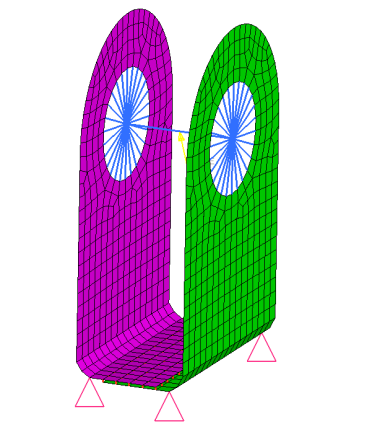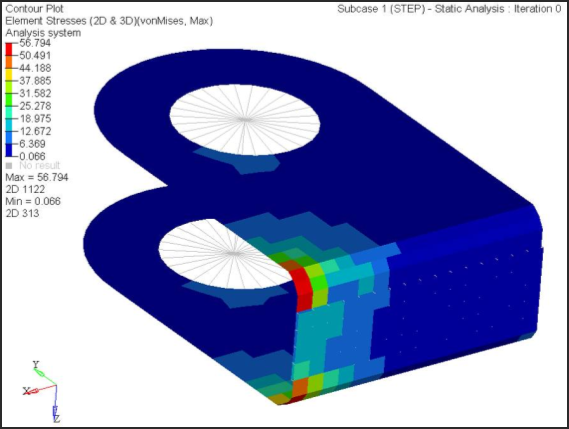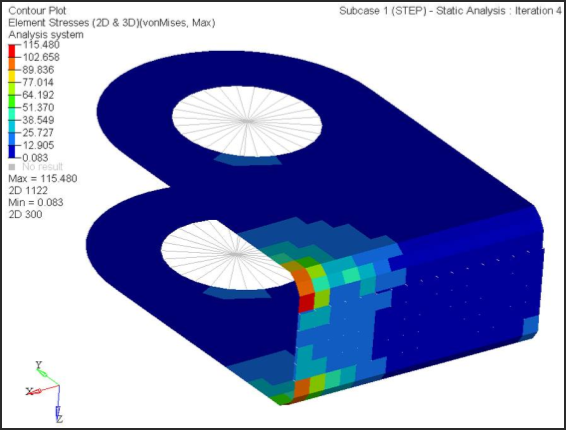This tutorial demonstrates how to perform a size optimization on a welded bracket modeled with shell elements using discrete design variables. The structural model with loads and constraints applied is shown in the figure below. The objective is to minimize the amount of material used in the model subject to certain stress specifications.

The structural model, as shown in the figure, is loaded into HyperMesh. The constraints, loads, material properties, and subcases (loadsteps) are already defined in the model. Size design variables and optimization parameters are defined, and OptiStruct determines the optimal gauges. The results are then reviewed in HyperView.
The optimization problem is stated as:
Objective:
|
Minimize volume.
|
Constraints:
|
Maximum von Mises stress of the brackets < 120 MPa.
|
Design variables:
|
Gauges of the brackets.
|
In this tutorial, you will learn to:
| • | Setup a size optimization with discrete design variables in HyperMesh |
| • | Post-process the optimization results in HyperView |
Exercise
Step 1: Launch the HyperMesh Desktop, Set the User Profile, and Retrieve the Database File
| 1. | Launch HyperMesh Desktop. |
| 2. | Choose OptiStruct in the User Profiles dialog and click OK. |
User Profiles can also be accessed from the Preferences menu on the toolbar.
| 3. | Select the Open Model file toolbar icon  . . |
| 4. | Select the bracket_size.hm file you saved to your working directory from the optistruct.zip file. Refer to Accessing the Model Files. |
| 5. | Click Open. The bracket_size.hm database is loaded into the current HyperMesh session, replacing any existing data. |
Setting Up a Size Optimization with Discrete Design Variables in HyperMesh
Step 2: Create the Design Variables
| 1. | From the Analysis page, click optimization to enter the panel. |
| 2. | Select discrete dvs to enter this panel. |
| 3. | Click on the field next to name= and enter DDV1. |
| 4. | Click on the field next to from= and enter the value 0.5. With the same method, enter 3.0 for to= and 0.1 for increment=. The TAB key can be used for faster inputs. |
This sets up a discrete design variable with a starting value of 0.5 and ending value of 3.0. The variables are incremented by 0.1, making the possible values as 0.5, 0.6, 0.7, and so on until 3.0.
| 6. | Create another discrete design variable, DDV2, with the same discrete values as DDV1. |
| 7. | Click return to go back to the optimization panel. |
| 9. | Select the desvar subpanel using the radio buttons on the left-hand side of the panel. |
| 10. | Click desvar = and enter part1. |
| 11. | Click initial value = and enter 2.5. |
| 12. | Click lower bound = and enter 0.5. |
| 13. | Click upper bound = and enter 3.0. |
| 14. | Toggle no ddval to ddval =. |
| 15. | Click ddval= and select DDV1 from the list. |
A design variable, part1, has been created. The design variable has an initial value of 2.5, a lower bound of 0.5, and an upper bound of 3.0 and is linked to a DDVAL (Discrete Design Variable Value) of the name DDV1.
| 17. | Repeat steps 10 through 16 to create the design variable part2 using the same initial value, lower, and upper bounds, linking it to a DDVAL of name DDV2. |
| 18. | Select the generic relationship subpanel using the radio buttons on the left-hand side of the panel. |
| 19. | Click name = and enter part1_th. |
| 20. | Click the entity selection switch and choose prop. |
| 21. | Click prop and select part1 from the list of component collectors. A property selection switch now appears below the prop button. |
| 22. | Click the property selection switch and select Thickness T from the pop-up menu. |
| 23. | Click designvars. The list of design variables appears. |
| 24. | Check the box next to part1. |
| 25. | The linear factor (value in box beside part1) is automatically set to 1.000. |
A design variable to property relationship, part1_th, has been created, relating the design variable part1 to the thickness entry on the PSHELL card for the component part1.
| 28. | Repeat steps 19 through 26 to create the design variable to property relationship part2_th, relating the design variable part2 to the thickness entry on the PSHELL card for the component part2. |
| 29. | Click return to go to the Optimization Setup panel. |
Step 3: Create the Responses
A detailed description can be found in the OptiStruct User's Guide under Responses.
| 1. | Select the responses panel. |
| 2. | Click response = and enter volume. |
| 3. | Click the response type: switch and select volume from the pop-up menu. |
| 4. | Click create. A response, volume, is defined for the total volume of the model. |
| 5. | Click response = and enter stress1. |
| 6. | Click the response type: switch and select static stress from the pop-up menu. |
| 8. | Click one of the green shell elements in the graphics window to select the component part1. |
| 9. | Click select. A stress type selector switch appears. |
| 10. | Click the stress type selector switch and select von mises from the pop-up menu. |
| 11. | Click the selector switch, below the stress selector and choose the both surfaces option. |
| 12. | Click create. A response, stress1, is defined for the von Mises stress of the elements in the component part1. |
| 13. | Click response = and enter stress2. |
| 15. | Click one of the pink shell elements in the graphics window to select the component part2. |
| 17. | Click create. A response, stress2, is defined for the von Mises stress of the elements in the component part2. |
| 18. | Click return to go to the Optimization Setup panel. |
Step 4: Create Constraints
A response defined as the objective cannot be constrained. In this case, you cannot constrain the response volume.
Upper bound constraints are to be defined for the responses stress1 and stress2.
| 1. | Select the dconstraints panel. |
| 2. | Click constraint = and enter stress1. |
| 3. | Click response = and select stress1 from the list of responses. A loadsteps button appears in the panel. |
| 5. | Check the box next to STEP and click select. |
| 6. | Check the box next to upper bound =. |
| 7. | Click upper bound = and enter 100. |
A constraint is defined on the response stress1. The constraint is an upper bound with a value of 100. The constraint applies to the subcase STEP.
| 9. | Click constraint = and enter stress2. |
| 10. | Click response = and select stress2 from the list of responses. |
| 12. | Check the box next to STEP and click select. |
| 13. | Check the box next to upper bound =. |
| 14. | Click upper bound = and enter 120. |
A constraint is defined on the response stress2. The constraint is an upper bound with a value of 120. The constraint applies to the subcase STEP.
| 16. | Click return twice to go to the main menu. |
Step 5: Define the Objective Function
In this example, the objective is to minimize the volume response defined in the previous section.
| 1. | Select the objective panel. |
| 2. | Click the switch in the upper left corner of the panel, and select min from the pop-up menu. |
| 3. | Click response = and select volume from the response list. |
| 4. | Click create. The objective function is now defined. |
| 5. | Click return to return to the Optimization Setup panel. |
Step 6: Submit the Job
| 1. | From the Analysis page, select OptiStruct to enter the panel. |
| 3. | Select the directory where you would like to write the OptiStruct model file and enter the name for the model, discrete_bracket_size.fem, in the file: field. .fem is the suggested extension for OptiStruct input decks. |
The name and location of the discrete_bracket_size.fem file displays in the input file: field.
| 5. | Set the export options: toggle to all. |
| 6. | Set the run options: toggle to optimization. |
| 7. | Set the memory options: toggle to memory default. |
| 8. | Click OptiStruct. This launches the OptiStruct job. |
If the job was successful, new results files can be seen in the directory where the OptiStruct model file was written. The bracket_size.out file is a good place to look for error messages that will help to debug the input deck if any errors are present.
Post-processing the Optimization Results in HyperView
Step 7: View the Stress Results
After the size optimization, the stress value should be reviewed to make sure that the stress constraints are not violated. The analysis results are available on page 3 (the second page has the optimization results).
| 1. | When the message Process completed successfully is received in the command window, click HyperView. |
This launches the HyperView into a new page and opens the results. A message window appears to inform about the successful loading of the model and result files into HyperView. Notice that all of the h3d files get loaded, each into a different page in HyperView. The files discrete_bracket_size_des.h3d and discrete_bracket_size_s2.h3d get loaded in pages 2 and 3, respectively.
| 2. | Click Close to close the message window. |
| 3. | Click the Next Page toolbar icon  to move to the third page. to move to the third page. |
The third page has the results loaded from the discrete_bracket_size_s1.h3d file. The name of the page is displayed as Subcase 1 – STEP to indicate that the results correspond to subcase 1.
| 4. | Click the Contour toolbar icon  . . |
| 5. | Select the first drop-down menu below Result type: and select Element Stresses [2D & 3D] (t). |
| 6. | From the second drop-down menu, select vonMises. |
| 7. | Select None in the field below Averaging method:. |

von Mises contour for the initial design.
A contoured image representing von Mises stresses should be visible. Each element in the model is assigned a legend color, indicating the von Mises stress value for that element resulting from the applied loads and boundary conditions. If you did not change the Iteration step you should be contouring the stress of the initial step. To contour the final step, set the last iteration of that loadcase using the  icon on the animation toolbar, or use the Results browser, as follows.
icon on the animation toolbar, or use the Results browser, as follows.
| 9. | Use the bottom drop-down menus in the Results browser to select the last Iteration # in the Simulation list. |
Notice only two iterations are displayed; the First and Last (FL) is the default setting for optimization runs. To change this setting, add an OUTPUT control card with a frequency setting of ALL.
This will now contour your final iteration of that loadcase. Review the stress to see that it is under the proper constraints.

von Mises contour for the optimum design.
Review
The .out file contains a summary of the optimization process. From the information in the .out file, you can see how the objective, constraints, and design variables are changing from one iteration to the next.
Has the volume been minimized for the given constraints?
Have the stress constraints been met?
What are the resulting gauges for the two parts?
Hints
Go to the des.h3d page, clear the contour if one was applied, set to the last simulation step and apply the Element Thickness contour.
Append discrete_bracket_size.mvw to review objective, constraints, and other information.
See Also:
OptiStruct Tutorials











